Do Labradoodles Like to Swim? Exploring Their Aquatic Affinity
Labradoodles, a popular crossbreed of Labrador Retrievers and Poodles, are known for their intelligence, friendliness, and energetic personalities. As a dog owner, you might wonder if these delightful dogs enjoy swimming.
Indeed, many Labradoodles possess a natural affinity for water and are enthusiastic swimmers.
Due to their parent breeds – both Poodles and Labrador Retrievers – having strong swimming backgrounds, it’s no surprise that many Labradoodles inherit this love for water. While it’s generally safe for your Labradoodle to swim in calm water, there are some precautions and training measures to ensure their safety and well-being.

However, it’s essential to remember that not all Labradoodles enjoy swimming to the same extent. Factors such as individual personalities, coat types, and physical abilities can influence a Labradoodle’s interest in and aptitude for swimming.
Key Takeaways
- Many Labradoodles are natural swimmers due to their Poodle and Labrador Retriever parentage.
- Prioritize safety and training when introducing your Labradoodle to swimming.
- Swimming abilities and interest can vary amongst individual Labradoodles.
Swimming Nature of Labradoodles
Labradoodles are a popular breed that many people adore. One of the questions you might have is whether they like to swim. Well, let’s explore the swimming nature of Labradoodles by diving into their heritage.
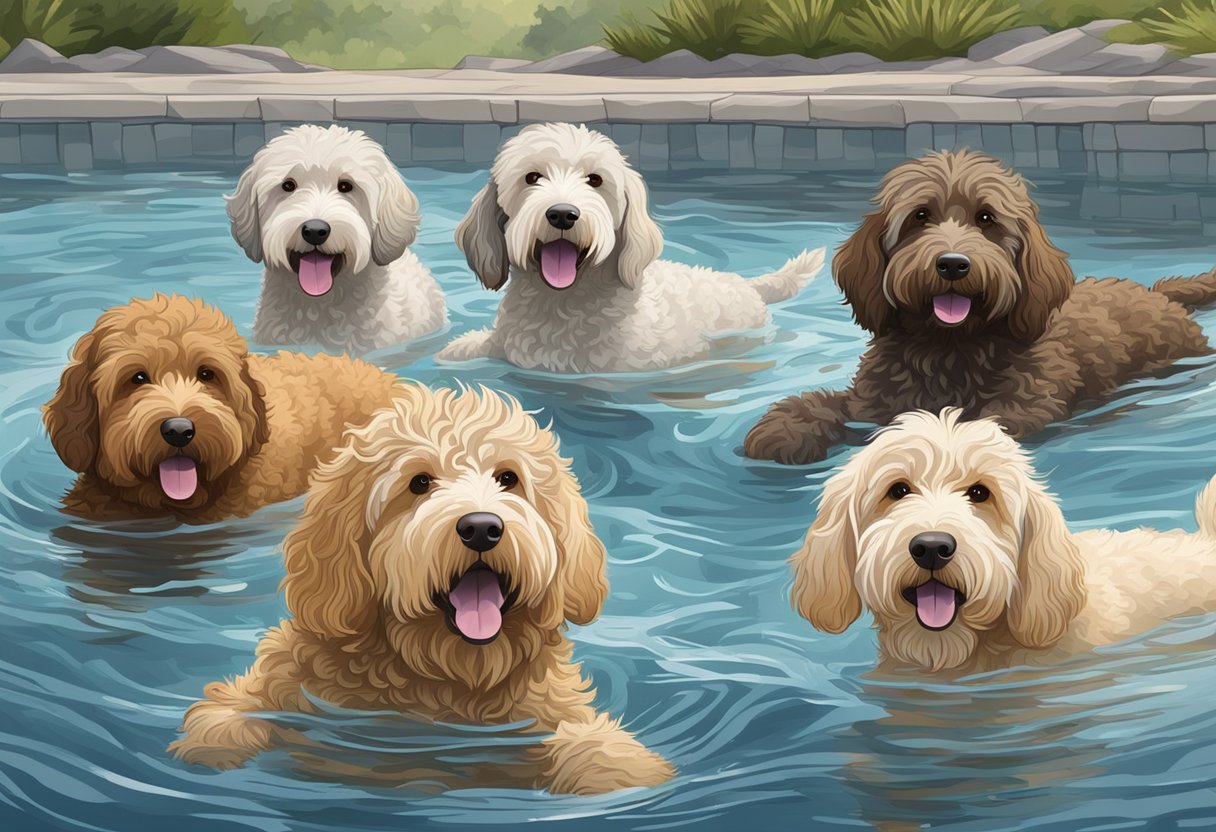
Heritage of Labrador and Poodle
Labradoodles are a crossbreed of two water-loving breeds: the Labrador Retriever and the Poodle. As both of their parent breeds are known for being good swimmers, it’s natural to assume that this trait would be passed on to their offspring.
Labrador Retrievers were initially bred to be ‘duck dogs’, trained to retrieve ducks and other waterfowl during hunting trips. This required them to be strong swimmers, hence their reputation as water-loving dogs. With their dense, waterproof coat and otter-like tail used as a powerful rudder, Labradors are perfectly suited for swimming.
Poodles, on the other hand, were water dogs used for various purposes such as hunting, retrieving, and even participating in water rescue operations. Poodles have a curly, non-shedding coat that provides natural insulation when swimming in colder waters, and their webbed feet help them navigate through water with ease.
Considering the strong swimming backgrounds of both the Labrador and Poodle, it’s safe to say that their Labradoodle offspring would inherit an affinity for water activities. Like their parent breeds, Labradoodles are known to be confident and capable swimmers, although individual preferences may vary.
In conclusion, if you’re considering a Labradoodle as your companion, it’s likely that they’ll enjoy splashing around and engaging in water-related activities. It’s essential to ensure their safety by providing proper supervision, flotation devices, and gradually introducing them to water to foster a positive experience.
Safety Measures for Labradoodles in Water
As a Labradoodle owner, ensuring your pet’s safety in the water is essential to make swimming sessions enjoyable and secure. There are a few essential precautions you should take whenever your dog ventures into the water.
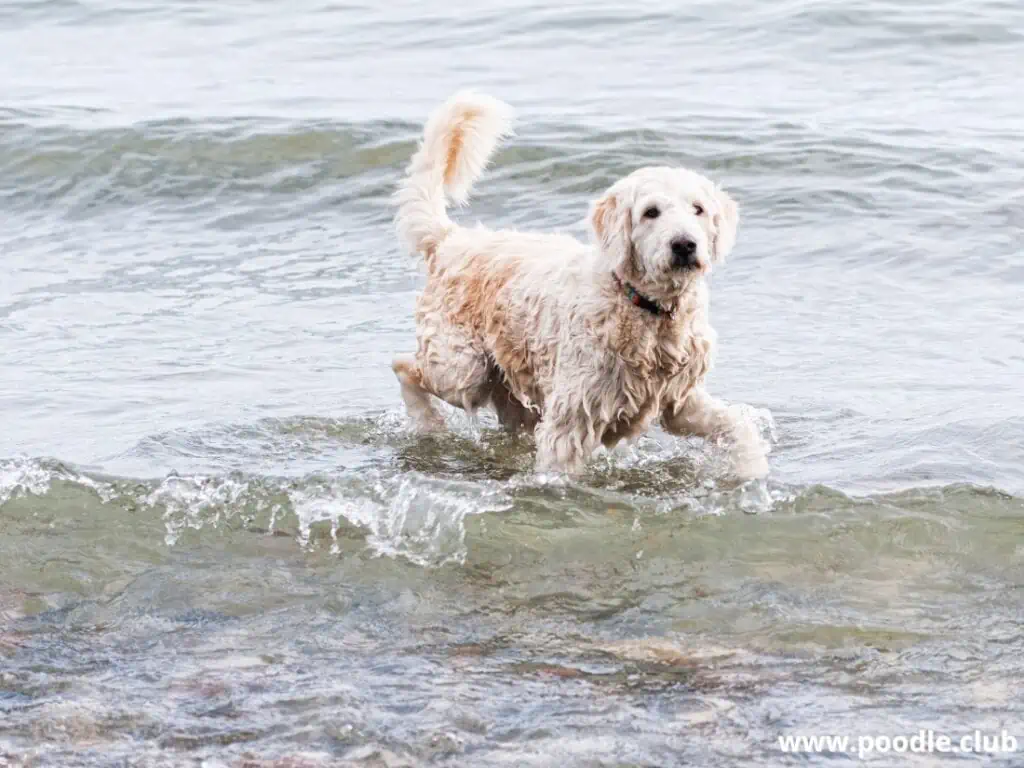
Protective Gear for Swimming Labradoodles
Equip your Labradoodle with a dog life jacket specifically designed to keep them buoyant and to make it easier for you to reach them if needed. Choose a jacket with highly visible colors and a handle for easy grabbing. Additionally, pay attention to the following factors when selecting a life jacket for your dog:
PuppySpot is a reputable dog marketplace where you can browse and find compatible puppies right from the comfort of your home. They have placed over 200,000 puppies into homes in the US!
- Proper fit: Measure your Labradoodle’s girth, length, and weight to ensure the jacket provides a snug but comfortable fit.
- Material: Choose a life jacket made of durable, water-resistant materials that dry quickly and ensure ease of movement in water.
Supervision and Safety Precautions
Your Labradoodle’s safety in the water depends on your watchful eye and vigilance. Never leave your dog unsupervised in or near water, whether it’s a pool, lake, or ocean. Consider the following safety precautions:
- Water entry: Encourage your Labradoodle to use a doggie ramp or steps to enter and exit the pool to avoid injury.
- Shallow water: Start in the shallow end, allowing your dog to get used to the water depth and gradually move to deeper areas.
- Strong currents: Avoid swimming in areas with strong currents as they can be dangerous for both you and your pet.
In addition to these guidelines, make sure your Labradoodle is aware of your pool’s location if you have one. Familiarize them with barriers and access points to prevent accidental plunges. Finally, consider enrolling your dog in swimming lessons or water sports activities that prioritize water safety.
This way, both you and your pet can enjoy the water while staying safe.
Training Labradoodles to Swim
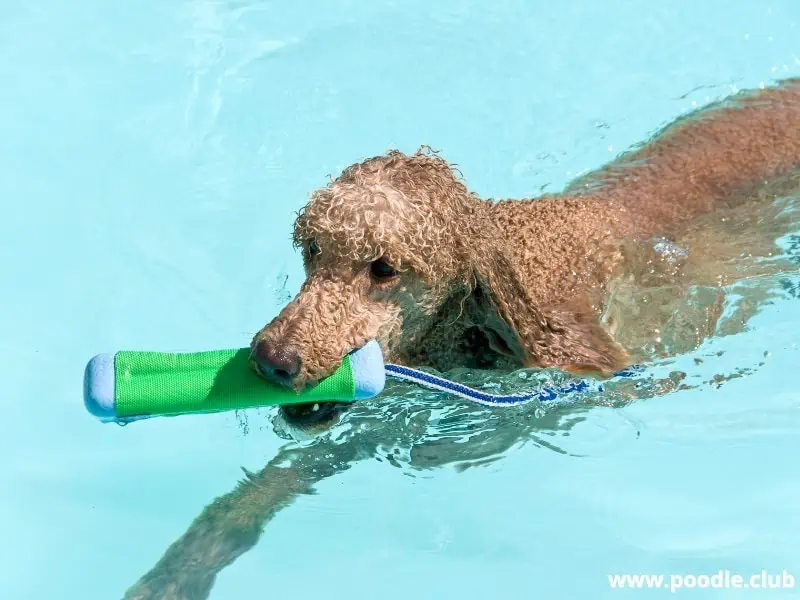
Building Comfort and Confidence in Water
Before you can teach your Labradoodle to swim, it’s important to make them feel comfortable and confident in the water. Start by exposing your dog to shallow water in a safe and controlled environment, such as a kiddie pool. Gradually increase the water depth as they become more at ease with the water.
Acclimate your Labradoodle to the essential swimming equipment, like a flotation device, by letting them wear it around the house before entering the water. Remember, positive reinforcement is key to successfully building your Labradoodle’s comfort in the water – always praise and reward them for their progress!
Incorporating Fun and Games in Training
Many Labradoodles naturally enjoy the water, so incorporating fun and games into their swim training can make it an enjoyable experience for both of you. Toys that float are an excellent way to encourage your dog to splash and swim. Try playing fetch with a toy designed for water use.
Another fun activity to engage in is dock diving, where you throw a floating toy off a dock, and your Labradoodle jumps into the water to retrieve it. Make sure to take breaks and offer lots of praise and encouragement throughout the training sessions.
While some Labradoodles may be natural swimmers, others may need more time and gentle guidance to feel at ease in the water. Remember to progress at a pace that’s comfortable for your dog, and the two of you will enjoy many water-based activities together, such as swimming, kayaking, or even surfing. The water can provide a fantastic source of exercise and mental stimulation for your Labradoodle while deepening the bond between the two of you.
Health Aspects of Swimming for Labradoodles
Benefits and Challenges of Swimming
Swimming is a healthy and enjoyable activity for your Labradoodle. It helps maintain your pet’s overall fitness and strengthens their joints and organs. For puppies, swimming can be a fun way to burn off excess energy, too.
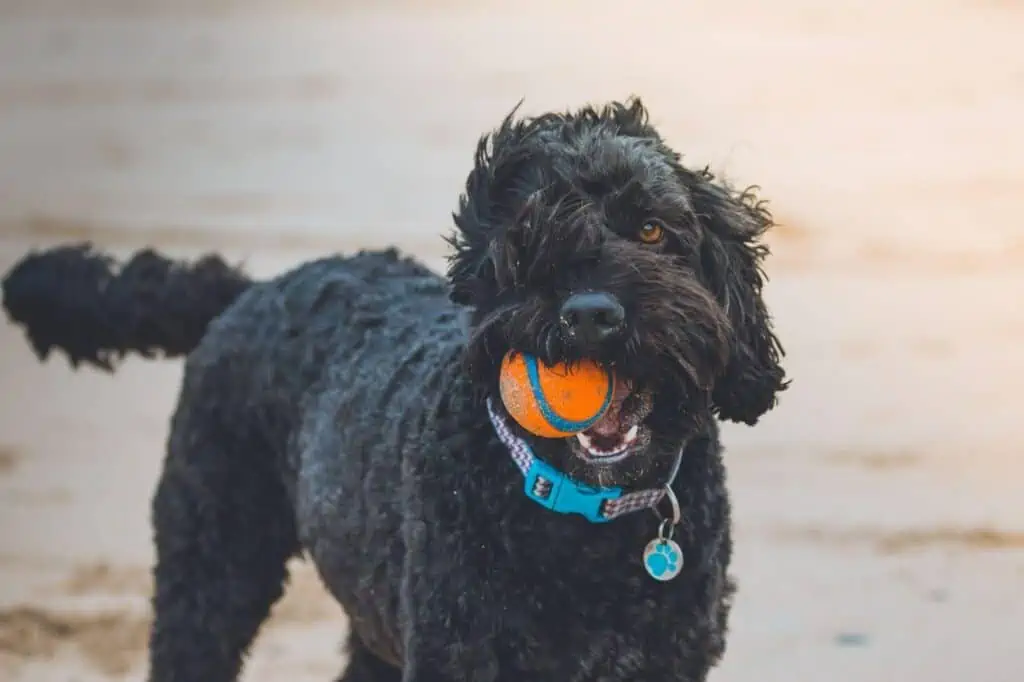
However, taking your Labradoodle for a swim comes with a few challenges. One issue is the potential for ear infections, as their furry ears can trap water and lead to inflammation. Another concern is dealing with their coat, which tends to become heavy and soggy after swimming.
To address these challenges:
- Monitor your pet – Keep an eye on your Labradoodle puppy while they swim, especially if they’re new to the activity.
- Pre-swim grooming – Trim the fur around your Labradoodle’s ears and coat before giving them some water time.
Dealing with Post-Swimming Care
After a swim, it’s important to properly care for your Labradoodle to avoid infections and maintain their coat’s condition.
- Dry their ears – Use liquid ear cleaners and a cotton ball to gently clean and dry your pet’s ears. This helps prevent ear infections and inflammation.
- Bathe your pet – Give your Labradoodle a bath to remove any debris or contaminants from their fur.
- Groom their coat – Comb or brush your Labradoodle’s coat to remove any tangles and keep it looking its best.
Remember, keeping your Labradoodle’s ears and coat clean following a swim is essential for maintaining their overall health and happiness.
Variations in Swimming Abilities among Labradoodle Types
Labradoodles, being a crossbreed between Labradors and Poodles, often inherit the love for water from their parent breeds. However, their swimming abilities can vary depending on the size and type of Labradoodle.
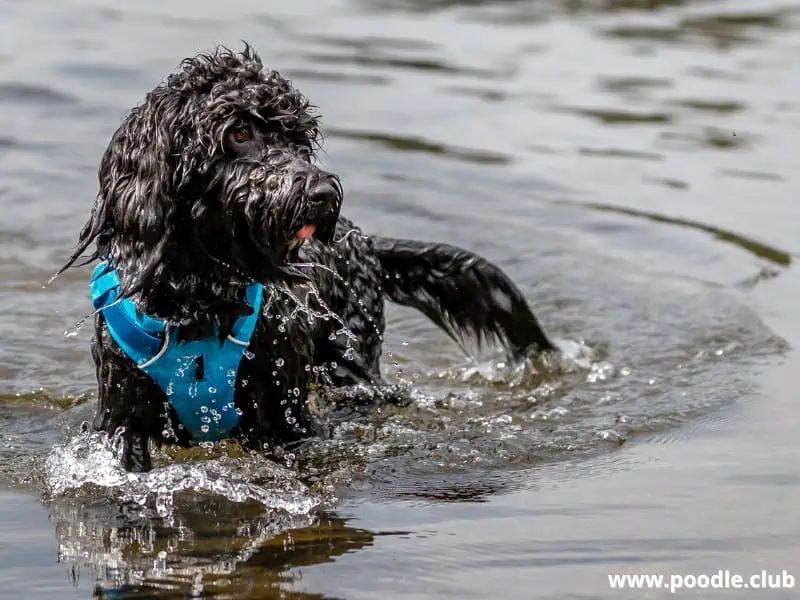
Mini Labradoodles are smaller in size and might not be as strong swimmers as their larger counterparts. Despite this, they still tend to enjoy splashing around in water and can swim with guidance and support. It’s crucial to monitor them closely and use floatation devices if needed, ensuring their safety in the water.
On the other hand, standard and medium-sized Labradoodles usually inherit the strong swimming skills of their Labrador and Poodle ancestors. Labradors, in particular, are water dogs with a natural affinity for swimming, which is passed down to their Labradoodle offspring. Poodles also have water retriever genetic traits, adding to the swimming prowess of Labradoodles.
Miniature Labradoodles, being smaller than both standard and medium Labradoodles, may exhibit slightly less confidence when it comes to swimming. However, these smaller Doodles can still be competent swimmers with proper training and supervision. They might need extra support in the water to make up for their smaller size, especially when swimming with bigger dogs or in deep water.
As a Labradoodle owner, it’s essential to take note of these factors and assess your dog’s swimming abilities individually. Early exposure to water and positive reinforcement during swimming sessions can go a long way in helping any Labradoodle, regardless of size, become more comfortable and skilled in the water. Remember to prioritize safety and enjoyment for both you and your furry friend in all aquatic adventures.




![Maltipoo vs Toy Poodle [Comparison with Photos]](https://poodle.club/wp-content/uploads/2022/12/maltipoo-vs-toy-poodle-768x512.webp)


![Dog Gums Are BLACK [Is This Normal?]](https://poodle.club/wp-content/uploads/2022/04/dogs-gums-are-black-768x512.webp)